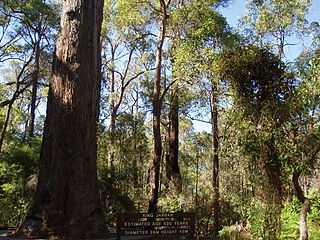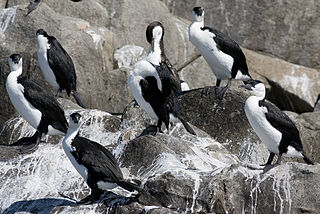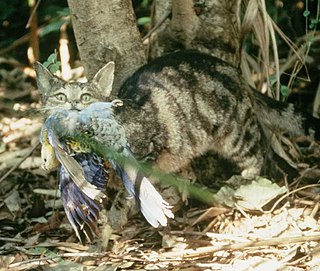
The dingo is an ancient (basal) lineage of dog found in Australia. Its taxonomic classification is debated as indicated by the variety of scientific names presently applied in different publications. It is variously considered a form of domestic dog not warranting recognition as a subspecies, a subspecies of dog or wolf, or a full species in its own right.

Yarra Ranges National Park is located in the Central Highlands of Australia's southeastern state Victoria, 107 km northeast of Melbourne. Established in 1995 and managed by the statutory authority Parks Victoria, the park features a carbon-rich, temperate rainforest and a subalpine eucalypt forest on its northern plateau. It is home to large stands of mountain ash, the tallest tree species in Australia and among the tallest in the world. A wide diversity of fauna make their home across the park's 76,003 hectares, including kangaroos, wallabies, wombats, platypuses and 120 species of native birds. Among the conservation challenges facing Yarra Ranges National Park are climate change and invasive species of weeds.
Taunton National Park is situated near the town of Dingo approximately 135 km inland from Rockhampton in eastern Central Queensland, Australia. The park encompasses an area of 11,626 ha within the Northern Brigalow Belt bioregion of Queensland; a region widely recognised to contain considerable biodiversity.

Invasive species in Australia are a serious threat to the native biodiversity, and an ongoing cost to Australian agriculture. Numerous species arrived with European maritime exploration and colonisation of Australia and steadily since then.

A feral pig is a domestic pig which has gone feral, meaning it lives in the wild. The term feral pig has also been applied to wild boars, which can interbreed with domestic pigs. They are found mostly in the Americas and Australia. Razorback and wild hog are Americanisms applied to feral pigs or boar–pig hybrids.

The ecological restoration of islands, or island restoration, is the application of the principles of ecological restoration to islands and island groups. Islands, due to their isolation, are home to many of the world's endemic species, as well as important breeding grounds for seabirds and some marine mammals. Their ecosystems are also very vulnerable to human disturbance and particularly to introduced species, due to their small size. Island groups, such as New Zealand and Hawaii, have undergone substantial extinctions and losses of habitat. Since the 1950s several organisations and government agencies around the world have worked to restore islands to their original states; New Zealand has used them to hold natural populations of species that would otherwise be unable to survive in the wild. The principal components of island restoration are the removal of introduced species and the reintroduction of native species.

A brumby is a free-roaming feral horse in Australia. Although found in many areas around the country, the best-known brumbies are found in the Australian Alps region. Today, most of them are found in the Northern Territory, with the second largest population in Queensland. A group of brumbies is known as a "mob" or "band".

The yellow-footed rock-wallaby, formerly known as the ring-tailed rock-wallaby, is a member of the macropod family.

A feral horse is a free-roaming horse of domesticated stock. As such, a feral horse is not a wild animal in the sense of an animal without domesticated ancestors. However, some populations of feral horses are managed as wildlife, and these horses often are popularly called "wild" horses. Feral horses are descended from domestic horses that strayed, escaped, or were deliberately released into the wild and remained to survive and reproduce there. Away from humans, over time, these animals' patterns of behavior revert to behavior more closely resembling that of wild horses. Some horses that live in a feral state but may be occasionally handled or managed by humans, particularly if privately owned, are referred to as "semi-feral".

The Cathedral Range State Park located in Victoria, Australia, approximately 100 kilometres (62 mi) north-east of Melbourne. It is situated between the towns of Buxton and Taggerty and runs parallel to the Maroondah Highway. The Cathedral Range was declared a State Park on 26 April 1979. It consists of 3,577 hectares and contains the rugged Razorback and spectacular peaks of the Cathedral Range, Little River and forested hills of the Blue Range. Due to its proximity to Melbourne the Cathedral Ranges are a popular destination for both day and weekend adventures. Bushwalking, camping, rock climbing and abseiling are some of the more popular activities available. Cathedral Range State Park is listed as Category II under the IUCN World Commission on Protected Areas and is an example of a park that can be used for recreation, education and conserving natural ecosystems.

Jarrah Forest, also known as the Southwest Australia woodlands, is an interim Australian bioregion and ecoregion located in the south west of Western Australia. The name of the bioregion refers to the region's dominant plant community, jarrah forest – a tall, open forest in which the dominant overstory tree is jarrah.
Scottsdale Reserve is a 1,328-hectare (3,280-acre) nature reserve on the Murrumbidgee River in south-central New South Wales, Australia. It is 79 kilometres (49 mi) south of Canberra, and 4 kilometres (2.5 mi) north of Bredbo. It is owned and managed by Bush Heritage Australia (BHA), which purchased it in 2006. The purchase was supportive of projects aiming to connect existing fragmented remnant habitat such as K2C. Since the 1870s up until 2006, the land was used for agriculture – primarily sheep grazing with some minor cropping. A significant component of the Reserve has been cleared of native vegetation.

The feral goat is the domestic goat when it has become established in the wild. Feral goats occur in many parts of the world.

The Paroo-Darling National Park is a protected national park that is located in the Far West region of New South Wales, in eastern Australia. The 178,053-hectare (439,980-acre) national park spans two distinct regions in the outback area. This region covers the arid catchments of the Paroo River and the Paroo-Darling confluence to the south.

The Barmah National Park, formerly Barmah State Park, is a national park located in the Hume region of the Australian state of Victoria. The park is located adjacent to the Murray River near the town of Barmah, approximately 225 kilometres (140 mi) north of Melbourne. The park consists of river red gum floodplain forest, interspersed with treeless freshwater marshes. The area is subject to seasonal flooding from natural and irrigation water flows.

The Yathong Nature Reserve is a protected nature reserve that is also a nationally and internationally recognized biosphere situated in the central-western region of New South Wales, in eastern Australia. The 107,240-hectare (265,000-acre) reserve was listed by UNESCO in 1977 as a Biosphere Reserve under the Man and the Biosphere Programme (MAB). The reserve is significant for its biodiversity in both native plant and animal species. Cultural heritage and historical grazing activities add to the significance of this site as a conservation area.

Goose Island is a small (2 ha), rocky island lying about 550 m from the northern end of the much larger Wardang Island, off the west coast of the Yorke Peninsula, in the Spencer Gulf of South Australia. Rising to a height of 26 m, its vegetation is dominated by African boxthorn on clay and calcarenite soils. The waters surrounding the island are protected in the Goose Island Aquatic Reserve. The island is leased from the Department of Environment, Water and Natural Resources by Scotch College and is co-managed by the two parties.
Australia has a population of about 25 million, with the Commonwealth Government's 2019 survey estimating there are 640,000 recreational hunters in the country. There are around 5.8 million legally owned guns in Australia, ranging from airguns to single-shot, bolt-action, pump-action, lever-action or semi-automatic firearms.

Cat predation on wildlife is the result of the natural instincts and behavior of both feral and owned house cats to hunt small prey, including wildlife. Some people view this as a desirable phenomenon, such as in the case of barn cats and other cats kept for the intended purpose of pest control; but scientific evidence does not support the popular use of cats to control urban rat populations, and ecologists oppose their use for this purpose because of the disproportionate harm they do to native wildlife. As an invasive species and predator, they do considerable ecological damage.
In biology, overabundant species refers to an excessive number of individuals and occurs when the normal population density has been exceeded. Increase in animal populations is influenced by a variety of factors, some of which include habitat destruction or augmentation by human activity, the introduction of invasive species and the reintroduction of threatened species to protected reserves.
















